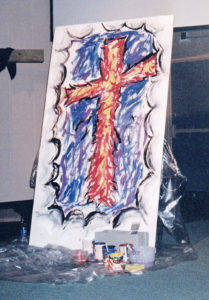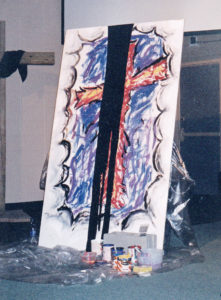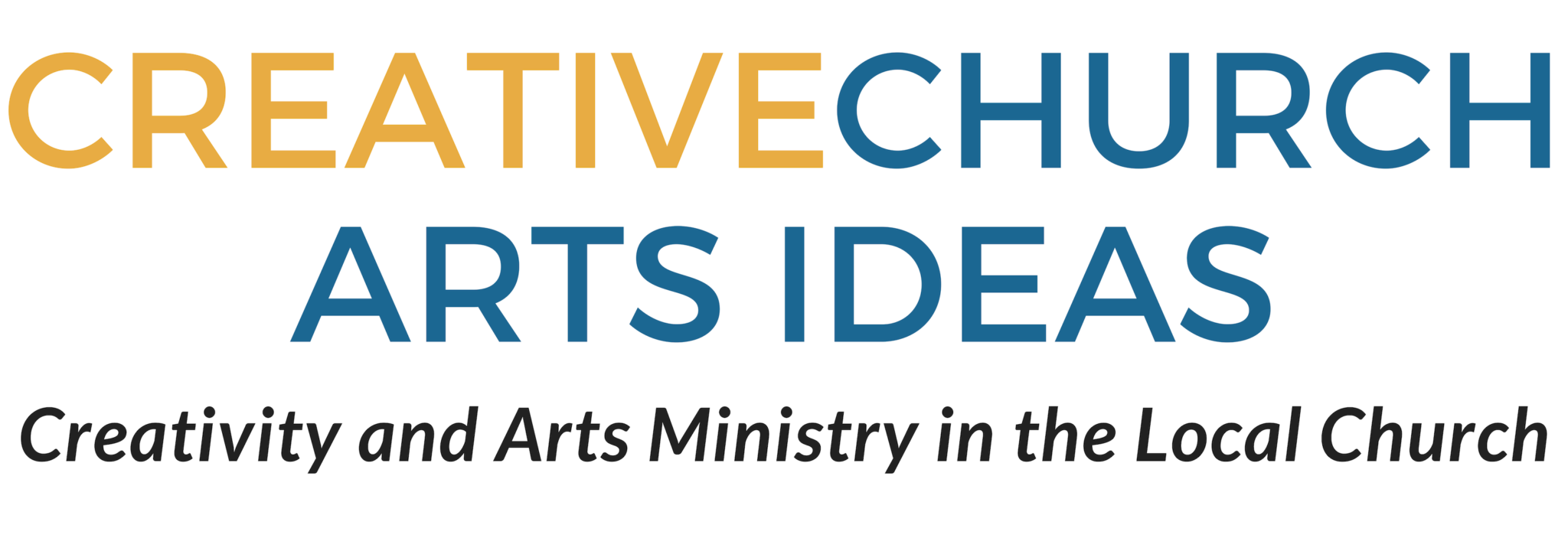Crosses painted live in Good Friday church services, then defaced, have a powerful impact.
(Adapted from Creative Church Handbook)
Concept: Provide a visual assist to the Good Friday story by painting three crosses on 4 x 8 Ft. sheets of plywood during the service and then immediately defacing them.
Background: The Good Friday story has been told thousands of times in many different ways. This concept offers the opportunity to relate the story with the assistance of simple
Good Friday art pieces, painted by members of your congregation as the story is being told.
How it works: First, pray about who your artists should be. Choosing people from your congregation will add to the emotional connection for the audience They don’t have to be excellent artists, because the pieces will be defaced right after they are created.
Set the three sheets of plywood up vertically at the front of your auditorium, spaced out along the stage. The stage-left panel will represent the repentant thief, the center panel will represent Jesus, and the panel on stage-right will represent the unrepentant thief. The panels need to be solidly anchored so that they stay still while being painted.
The artists will begin painting their crosses when the service begins, and paint continuously as the readings progress. The readings could include Scriptures from each of the Gospels, interlaced with appropriate songs. Just before the story reaches the moment of death the artists stop painting and step behind their panels, leaving an unobstructed view for the audience for up to sixty seconds as the story ends. On cue, the artists quickly elevate the bucket attached to the top and back of their panel, and the black paint in it begins to ooze down the front of the painting, defacing the cross they each just painted. This process continues for a few minutes and then the service ends in silence. Sometime before or during the service, but not right at the end, the audience should be instructed to that the service will end in silence. They can then linger in silence, come to the front to pray or leave in silently.
Additional elements might include sound and lighting effects—maybe a thunderclap with a flicker of the stage lights before the black paint is poured, and the sound of rain as it runs down  the panel. You might also have the artists remain behind their paintings and turn off their work lights one at a time after the paint has covered the middle of the panel.
the panel. You might also have the artists remain behind their paintings and turn off their work lights one at a time after the paint has covered the middle of the panel.
Result: This project puts the audience in a meditative state as they watch the artists creating the paintings while the Good Friday story is being read. Some will experience joy as they watch people they know create these works. Then the unexpected defacing of the painting really connects the emotions with the moment of death in the story. It’s common to hear crying and other emotional expressions throughout the congregation. Many may want to linger in their seats, processing it. And you’ll likely hear many stories of how people were deeply affected by the service. This Good Friday art service can become an important link in many people’s connection with Good Friday.
One particularly talkative and outgoing young couple left one of these services in sacred silence, drove the twenty-minute trip home together and didn’t speak until nearly an hour later. They then felt compelled to drink a glass of wine as a commemorative sacrament. They still talk about the experience more than ten years later.
Materials needed:
- Three four-by-eight-foot, half-inch-thick sheets of plywood (per service, if multiple services)
- Three one-quart rigid buckets, with one flat side on each
- Three medium to large door hinges with screws

- Six large plastic tarps (at the very least)
- Three extra heavy-duty artist easels (preferably not three-legged), or a two-by-four-inch board mounting system that you devise to hold the panels up
- Several medium-sized jars to put paint in. Each artist should have dedicated jars of paint, with a dedicated brush. This is a quick process, and you don’t want to have to clean brushes as you work.
- Duct tape
- Paint, brushes and a small table for each artist
- One work light for each artist (attach to top of panel)
Details:
- Use half-inch-thick plywood or very rigid quarter-inch. The board should not flex much or the paint in the bucket on the back may spill. Three-quarter-inch is too heavy and more expensive.
- Prime the panels with white or light-colored paint so that when the black paint is poured it will be easily seen. Encourage the artists to use and colors and style they like to paint their crosses.
- Take the one-quart buckets, with one flat side each (important), and attach one side of the door hinge to the flat side of the bucket. Attach the other side of the hinge to the top back of the panel. You will be lifting it from behind. Place duct tape over the crack between the panel and the bucket, to avoid spilling when the paint-filled bucket is tipped.
- Note that this can be a very messy project. Be very generous with tarps and plastic to cover the ground around and behind each panel, going out several feet in every direction. Tape the tarps securely together to avoid seeping paint. Do everything possible to ensure no paint will get on the stage, sanctuary or surrounding areas. You want to show leadership that a project like this can be done without any permanent impact on the worship space.
- Fill the hinged buckets with black paint shortly before the service. Cover the buckets with an airtight cover to prevent spillage and drying.
- When the artists step behind the panels, they uncover the buckets. When it comes time to tip the buckets, they should tip them quickly to avoid spilling. You’ll want tarps behind the panel to catch any spilled paint.
- You might also create a trough with tarps or tape at the base of the panel to catch the paint more effectively.
- I’d recommend that you experiment with the process before the night of the service. You may find ways to improve or simplify your specific application.
(Adapted from Creative Church Handbook by J. Scott McElroy)
Contribute your creative church service projects and ideas HERE!



An Artful Lenten Season • CREATIVECHURCH ARTS IDEAS
[…] The Good Friday Crosses is a powerful live art project that has touched many. […]